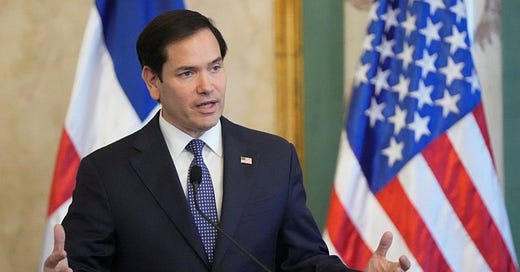The Rubio Update of the Monroe Doctrine
What an America First foreign policy in Latin America looks like.
Last month, the Manhattan Institute’s in-house publication, City Journal, has launched a new podcast, cleverly titled City Journal Podcast. I’m one of a rotating cast of panelists, due to appear two or three times a month. So far I’ve appeared on four episodes, which you can listen to (and read the transcripts) here, here, here, and here. You can also subscribe at those links, or wherever you get your podcasts. —IS
With Secretary of State Marco Rubio’s appointment as national security adviser, and President Donald Trump’s recent comments about Rubio’s chances to be his successor, the secretary of state has the unique chance to draft a foreign policy where “America First” means leading in our own hemisphere. That is, the second Trump administration should marry nationalist priorities with regional leadership. Call it the “Rubio Doctrine,” a 21st-century updating of James Monroe’s famous warning to Old World powers to stay out of our backyard. An America First agenda can now be strengthened by renewed engagement with our near neighbors.
Economic Opportunity and Friend-Shoring
Latin America is a sleeping economic giant that aligns perfectly with U.S. “friend-shoring” goals. Rather than relying on factories an ocean away, we can shift supply chains from Asia to the Americas. This isn’t wishful thinking; companies are already eyeing Latin America as global firms seek to decouple from China. The Western Hemisphere boasts resources and capacities the U.S. vitally needs.
For example, roughly 60 percent of the world’s identified lithium reserves are in Latin America, mostly in Bolivia, Argentina, and Chile. Likewise, Brazil holds the third-largest reserves of rare earth minerals globally, which are essential for everything from smartphones to fighter jets. Venezuela’s largest proven oil reserves could serve as an energy hub for the continent, particularly if that country can be freed from the demagogic ruling class’s tenuous grip on power. Tapping these resources through closer trade ties would strengthen U.S. industries and reduce dangerous dependence on China, which today supplies the vast majority of rare earths.
Recent trade dynamics give the U.S. new leverage to make this happen. The Trump tariffs on Chinese goods — even after the “golden age” trade deal — have raised the cost of outsourcing to Beijing, incentivizing production to move closer to home. Beijing has even tried to dodge U.S. duties by routing exports through “friends” in Latin America and Southeast Asia, proving that supply chains will reorient when costs rise. This friend-shoring would fortify U.S. supply lines against global shocks and create growth across the Americas. It’s a win-win: we reduce reliance on a strategic rival while our neighbors gain jobs and investment, knitting the hemisphere closer together.
This friend-shoring would fortify U.S. supply lines against global shocks and create growth across the Americas.
Importantly, as Western Hemisphere markets prosper, the economic drivers of illegal immigration weaken, advancing U.S. border interests. At the same time, this approach signals to the world that we prioritize commerce with aligned nations, reducing dependence on anti-American regimes that seek to challenge U.S. global leadership. Recent moves, such as U.S. pressure that convinced Panama to quit China’s Belt and Road initiative, show that assertive American leadership can swing the pendulum.
Keep reading with a 7-day free trial
Subscribe to Shapiro's Gavel to keep reading this post and get 7 days of free access to the full post archives.



